 |
| Glimpsing and engaging the potential of all children |
My vision of the great opportunity that children’s
museums enjoy on behalf of children has greatly expanded over the last 40 years. When I helped start Madison Children’s Museum in 1980 and when I
worked at Minnesota Children’s Museum, I was inspired by what was immediate,
physical, and fascinating to children. I focused on the value of objects and
environments in children’s development, play, and learning; providing more
children with richer, more varied environments; and expanding the range of
objects and materials children could manipulate, investigate, and transform
through exploration and play. Those are still compelling interests just as I
believe that every museum must be a great place to visit, enjoyable for children and families to
spend time together, bring friends, and celebrate.
With time and growth—mine, others involved with children’s museums, and children’s museums themselves—we’ve developed a deeper understanding of the fundamental relationship between the well-being of towns, cities, and regions and the well-being of children and families and how children’s museums contribute to this.
While a children’s museum may make a city more attractive to families, that’s not enough.
The prospects of a town, city, or region and its children are closely intertwined. Children have a lot to gain or lose from the quality of the towns, cities, or regions where they live. Children’s museums have an opportunity to help change those lives.
| When children thrive, cities thrive. |
Imagine
a city without children; a town without schools; or neighborhoods without playgrounds
or young families. When cities do not value children or address their needs and
those of families, families move away. These places become hollow. A city
without children is a city without a future. Conversely,
when children are attached to their neighborhoods, feel connected to place and cared
for by their community, they want to stay, return, contribute to these places
as adults. When children thrive, their communities thrive.
Alison Gopnik, professor of
psychology at the University of California, Berkeley, among
many others, says the central project of every human community is to care for
its children. At
the core of this work is valuing children, which is much more than saying we value children. It requires demonstrating
respect for them by assuring their physical and emotional safety and a time and
a place to be children. It demands that we appreciate them for who they are at every
moment of their development, and are respectful of the great possibilities each
child holds.
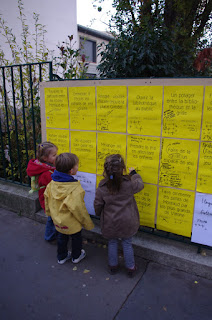 |
| Strong towns and cities welcome children into civic life. |
These are not just niceties, opportunities we hope
some lucky children enjoy. To the contrary, they are among the experiences
critical to all children’s optimal social, emotional, physical, and
intellectual development and essential to children becoming strong, caring,
responsible citizens. For all children these experiences provide a solid start
in life. For many, they become protective factors against adversities children
will encounter.
How we provide for our cities’
and citizens’ futures matters greatly. A town or city’s quality is more than a vibrant place architecturally, socially, commercially. Strong
towns and cities welcome children into civic life; invest wisely through their
futures in their everyday and long-term decisions. Our cities, towns, and regions,
along with children’s museums, libraries, zoos, and schools, need to ask
whether we are creating the future we want for our children.
Making Children Visible to the City
Not only do children’s museums
help make cities more attractive, they also contribute to children
becoming empowered and invested museum goers, agents in their own learning, and
engaged, productive citizens.
Children’s museums need to and want
to matter. Purpose-driven
organizations that serve tens of millions of children each year across this
country and around the world, children’s museums’ foundational ideas converge
around all domains of children’s healthy development; developmental
relationships with parents and caregivers;
varied, engaging experiences with materials and environments; and supportive community
connections.
Placing
their audience in their name establishes children’s museums’ core interest.
They are not about objects, but about people; they are not about something—art,
natural history, science, but are for children. Whether large or small, established or
fledgling, urban or rural, children’s museums serve parents, caregivers,
educators, and communities because they serve children. Serving children first has earned the loyalty and trust of children and families.
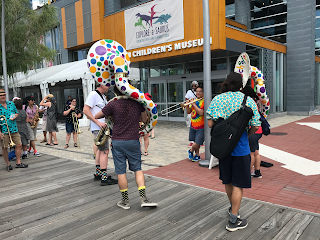 |
| Places for children |
In
being for children, children’s museums are attentive to what is intriguing to
children. They create varied experiences that engage, encourage, and challenge
children’s continuously developing and emerging capabilities which may present as interests, skills, dispositions, or abilities that are capable of being developed, across
all domains. Social places where family groups go to be
together and connect with one another, children’s museums are also spaces
family, school, and community groups from across a region meet and interact. Woven
into the community fabric, they help build a sense of belonging and add to the region’s infrastructure for well-being. Whether occupying a large stand-alone
building or operating in a small shared space, whether in a 5,000 or 400,000 s.f. space, every children’s museum space
stands as an investment and belief in children’s potential, what is possible but not yet fully
actual.
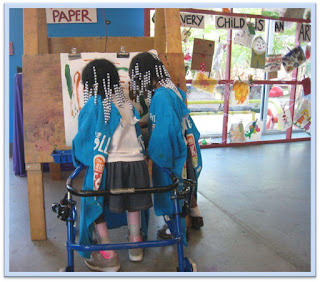 |
| Shaping how we view, value, and understand children |
Children’s museums’ long-term interest in
and knowledge about children represent a prime opportunity to make children, their capabilities,
and strengths visible to the city and to
shape how cities and their residents view, value, and understand children.
Everyday these museums welcome hundreds
and thousands of babies, big kids, and tweens and engage and support parents, caregivers,
and teachers. They use and conduct research to inform practices; create interactive
experiences with objects, environments, and other visitors; they expand and
enrich children’s understanding of their worlds. Across multiple media platforms children’s museums
communicate their messages, share stories, and promote their activities and
events to members, partners, and the larger community. They display children’s constructions,
projects, and accomplishments. Outreach and mobile units take children’s
museums into schools, parks, libraries, and neighborhoods.
This Remarkable Opportunity
Children’s museums’ remarkable opportunity
is that they both invite children to get to know their communities and they
invite communities to get to know their children. Fulfilling this opportunity relies on championing an image of the child—of all children—as actively interested in the world, attuned
to possibilities, open to relationships, and full of potential.
 |
| (Not a strong image of the child) |
Every one of us carries an image of the
child inside of us. This image is
critical because how we see children shapes our expectations of them as individuals
and as a group. Whether they are our own children, museum visitors, students, or
neighbors; whether we see them as responsibilities, consumers, or contributors,
our image affects how we relate to, talk with, observe, and understand them and choose opportunities for them.
It is impossible to overstate the power of this image. If children
grow up into our image of them—and we know they do—wouldn’t we much prefer that
they grow up being curious, resourceful, helpful, caring, confident? Yet, carrying an image of the child based
on strengths and possibilities rather than weaknesses is harder than we imagine.
While
many museums have statements about valuing and
respecting children, even the firmest beliefs in children as capable and
competent encounter contrary forces, images, and messages about them
in and outside the museum.
For starters, we have long been
underestimating children because of their size, their short attention spans, their
physical activity, and everything they have yet to learn. Over the last 40
years of research on children, however, we have found out not children’s
weaknesses and problems, but their capabilities and assets. Research tells us
that children are born knowing a lot about the world and other people; that
long before they can read or write, they have extraordinary powers of
imagination and creativity; that they start understanding the mind before the age of 2. Everyday observations of children confirm they are always on the verge
of something new.
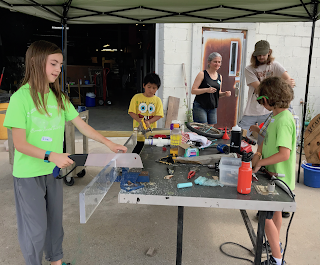 |
| Everyday, children are on the verge of something new. |
Unfortunately, when we don’t focus on
potential and strengths—children’s or others’—we tend to focus on problems. We
see limitations and deficiencies needing to be fixed. Rather than being attentive and amazed by what children
have accomplished and can do by 2, 5, or 8 years, we focus on what they don’t know or can’t
do. Often, we confuse the fact that children are novices in areas in which they
have an understandable, age-related, limited range of experience with their not
being capable. Think of the many children 3 or 4 years and younger who develop
an impressive fund of knowledge on topics interesting to them. Their expertise
may be dinosaurs, earth-moving machines, horses, or sports stars. They
use accurate terminology, have domain-appropriate schema, and make subtle
distinctions that escape most adults. Their focus, persistence, and motivation
to learn are apparent and impressive. Yet we focus on what they don’t know, or that
they can’t spell or read.
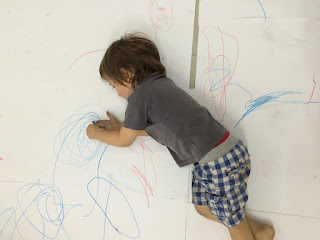 |
| The idea of making meaningful marks starts early |
We
also interpret emerging skills as failed efforts. When we see the marks that
toddlers make on a page using pens or pencils, we see these marks as scribbles.
Messy, careless, they don’t resemble letters and numbers so they don’t qualify
as writing. We are unlikely to see them as a toddler’s emerging understanding
that marks have meaning; or as drawings that represent and communicate ideas;
or as evidence of agency. And, while we are delighted to think about children
having questions about why things happen and investigating them, we fervently
hope these explorations aren’t too messy, noisy, or active.
We have ample
evidence of children as complex and complete from
birth with an inherent competence and eagerness to learn, teach, and form connections.
We also
know that building on such an asset-based view of children is in the best,
long-term interest of both communities and children. Too often, these views recede
into the background, and may not be considered at all.
Leading
with a Strong Image of the Child
Individually
and as a group, children’s museums need to be out in front, actively shaping a
view of children as strong, capable, and essential to the community’s well-being
as well as creating experiences that favor this view.
 |
| Social, caring, interested in relationships... |
To
make children and their potential, or potentials, visible, children’s museums
must firmly hold an image
of the child as competent
and full of possibility. While the particular image of the child is
specific to each museum and its community, every image reflects strengths. And
there is no lack of assets to highlight. Children are inquisitive, bold, and resourceful. They have ideas
and hunches and negotiate with everything the
environment brings to them. They
are social, caring, and interested in relationships. They are thinkers, doers, experimenters,
and learners. Inventors
who collaborate, they are confident individuals who communicate. From birth, children are active agents in forging their understanding
of the world.
While summarizing this on-going, life-changing
work of building communities that value children for their strengths and
potential is not simple, inevitably
it involves
the following.
• Articulating
a shared understanding of the child as strong, capable, and pull of potential.
Each museum will find its
own path to developing, working with, and broadly sharing an image that is: grounded in
its vision and mission; explored through multiple,
lively internal discussions; strengthened by on-going observations of children; and based in research. An image of the child becomes magnetic
north across a museum in all of its work.
• Reflecting
on an evolving a view of the child. Centering the museum’s language, thinking,
planning, and practice around this image takes hold gradually. Over time, revisiting the
museum’s view of children, how it’s understood in changing contexts becomes an established
practice that generates new insights and shifts. This process deepens and
enriches the image of the child and connects it to the museum’s thinking,
learning, creating, and growing.
• Listening
to and learning from children. Children’s talk, gestures, and actions; what they make,
and unmake; how they act with confidence or hesitation; what they choose and
avoid provide a wealth of information about them and how they experience and understand their
world. Information
and insights from children provide new perspectives and starting points for planning
museum offerings.
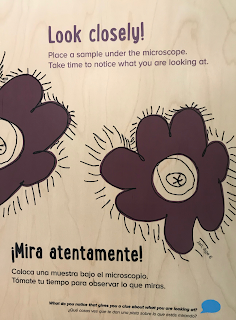 |
| Children's work can challenge adults' views of children are able to do |
• Creating
environments and experiences that are responsive to and leave room for children’s unfolding capabilities. Engaging children’s strengths and potentials
involves shifting from what they should do, to what they can do; from
doing things in a predetermined way, to doing things the child’s
way; from teaching skills to activating skills. Emphasizing and amplifying strengths
generate new, more inclusive approaches and a wider range of possibilities.
• Capturing
and documenting insights into children’s capabilities. Integrated into
museum experiences as activities, text, and images, children's input and examples of children’s projects, words, images, and drawings both
inform and challenge adults’ views of children and what they are able to do;
and elevate their value of children’s thinking, observation skills, and knowledge. Compelling examples of children’s capabilities,
children’s words and images anchor the museum’s messages about children and their strengths.
• Cultivating
a whole-hearted commitment from many stakeholders. Meaningful change in how
a community values its children is unrealistic without shifting how we all see
children. Children’s museums’ work helps partners, allies, and friends, towns, cities, and regions, recognize the importance
of what is possible but not yet actual for children. While caretakers of
this work, children’s museums must work closely with others and boldly lead this
greater effort.